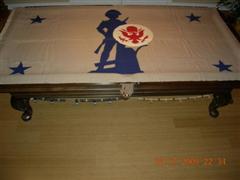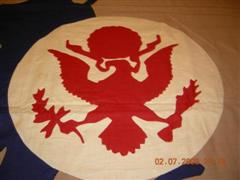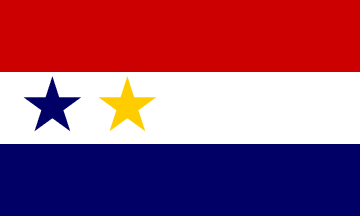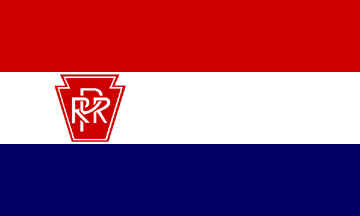![[Savings Bond flag]](../images/u/us_treasu.gif) image by Dave Martucci, 15 March 2006
image by Dave Martucci, 15 March 2006

Last modified: 2023-10-07 by rick wyatt
Keywords: united states | savings bonds | minuteman |
Links: FOTW homepage |
search |
disclaimer and copyright |
write us |
mirrors
See also:
The Minuteman flags were awards of the US Treasury Department during World War II for meeting or exceeding US Bond sales to pay for the war. The basic design was patented on August 18, 1942, by the Secretary of the Treasury.
Dave Martucci, 4 January 2010
![[Savings Bond flag]](../images/u/us_treasu.gif) image by Dave Martucci, 15 March 2006
image by Dave Martucci, 15 March 2006
This flag is still in use. From 1942 until sometime in the 1960s or 1970s it was awarded to businesses enrolling
90% or more of their employees in a Payroll Deduction program for buying Bonds. Today it is awarded for 50% or more participation and is available to schools, businesses, military units and federal agencies.
On it in white silhouette is a representation of the famous "Embattled Farmer" statue created by Daniel Chester French in 1874 that is in Concord, Massachusetts next to the North Bridge where the first battle of the American Revolution
took place. It is commonly called the "Minuteman".
Dave Martucci, 15 March 2006
![[Savings Bond flag]](../images/u/us_tresch.gif) image by Dave Martucci, 15 March 2006
image by Dave Martucci, 15 March 2006
Awarded to schools where 90% of the students were regularly buying War Stamps or Bonds.
Dave Martucci, 15 March 2006
![[Savings Bond flag]](../images/u/us_tre10.gif) image by Dave Martucci, 15 March 2006
image by Dave Martucci, 15 March 2006
Awarded to businesses where 90% or more employees participated by subscribing 10% or more of the Gross Payroll. Probably superseded by the T flag shortly after it was introduced. Placement of the red ball and whether it was fimbriated or not varied.
Dave Martucci, 15 March 2006
![[Savings Bond flag]](../images/u/us_trebey.gif) image by Dave Martucci, 9 June 2019
image by Dave Martucci, 9 June 2019
Awarded to businesses achieving full 100% employee participation.
Dave Martucci, 15 March 2006
![[Savings Bond flag]](../images/u/us_treast.gif) image by Dave Martucci, 15 March 2006
image by Dave Martucci, 15 March 2006
Awarded to businesses where 90% or more employees participated by subscribing 10% or more of the Gross Payroll.
Probably replaced the 10% flag.
Dave Martucci, 15 March 2006
![[Savings Bond flag]](../images/u/us_tretst.gif) image by Dave Martucci, 15 March 2006
image by Dave Martucci, 15 March 2006
Awarded to businesses where 90% or more employees participated by subscribing 10% or more of the Gross Payroll and the business met their full quota for the year.
Dave Martucci, 15 March 2006
![[Savings Bond flag]](../images/u/us_trered.gif) image by Dave Martucci, 15 March 2006
image by Dave Martucci, 15 March 2006
Nothing is known about this design except that an actual flag made by the Sherritt Flag Company exists.
Dave Martucci, 15 March 2006
![[Savings Bond flag]](../images/u/us_trea1y.gif) image by Dave Martucci, 15 March 2006
image by Dave Martucci, 15 March 2006
A current design signifying the business has met the minimum participation requirements for a second consecutive year. An additional star is added for each consecutive year. The size and placement of the star varies.
Dave Martucci, 15 March 2006
![[Savings Bond flag]](../images/u/us_trea5y.gif) image by Dave Martucci, 15 March 2006
image by Dave Martucci, 15 March 2006
A current design signifying the business has met the minimum participation requirements for five consecutive years. In theory, any combination of white and gold stars may be added to a flag depending on the number of consecutive years of qualification.
Dave Martucci, 15 March 2006
![[Savings Bond flag]](../images/u/us_trea11y.jpg) image by Fred Schwan, 20 March 2016
image by Fred Schwan, 20 March 2016
I just purchased a Minuteman flag on ebay that has three stars at the lower right corner. Two are gold and one is white. I suspect that this flag is for the the 11th year of qualifying for the Minuteman flag.
Fred Schwan, 20 March 2016
This photo explains the symbolism of the stars awarded for participation in the U.S. Savings Bond Program. Each gold star is for 5 years consecutive of by at least 50% of employees participating and each white star is for 1 year of at least 50% of employees participating in the program.
Zachary Harden, 21 March 2016
![[Savings Bond flag]](../images/u/us_svbd.gif) image by Nathan Bliss, 16 September 1999
image by Nathan Bliss, 16 September 1999
It's a savings bond participation flag awarded by Treasury to federal/military organizations that have a high rate of participation in annual savings bond drives. A Concord minuteman surrounded by stars.
Joe McMillan, 16 September 1999
The flag is dark blue, the same shade as the blue of the U.S. flag, with the silhouette of the Concord minuteman* in white surrounded by a circle of 13 white stars. It was once--and may still be--awarded by the U.S. Department of the
Treasury to organizations that met a particular standard for participation in the sale of savings bonds through payroll deductions. The organization could then fly the flag for a one-year period until the end of the next year's bond drive.
____________
*The American Revolution began on 19 April 1775 with clashes between colonial militiamen, known as "minutemen" from the short time in which they were supposed to be ready for action, and British regular troops at the Massachusetts towns of Lexington and Concord. There is a minuteman statue at the site of each battle. That at Lexington portrays a bare-headed minuteman holding his musket in both hands. The one at Concord shows a minuteman wearing a three-cornered hat supporting his musket with one hand, the other hand resting on a plow.
Joe McMillan, 18 September 2002

 Image by Greg Hunter, 19 February 2008
Image by Greg Hunter, 19 February 2008
From all the information I have received so far, I believe this flag is a post [US] Civil War Flag, sometime between (1870s & 1920s). Could be somehow associated with War Bonds - however, prior to 1932. The flag is beige, a blue Minuteman silhouetted in the center and a blue star in each corner. A red with white background shield in center of Minuteman.
Greg Hunter, 19 February 2008

 image by
António Martins-Tuválkin, 14 September 2023
image by
António Martins-Tuválkin, 14 September 2023
On page 24 of the 1943.12.13 issue of LIFE magazine, a full color,
full page ad explains how accurate railroading is an important part of the U.S.
war effort: [https://books.google.com/books?id=FVUEAAAAMBAJ&lpg=PA36&vq=montana&pg=PA24#v=onepage&q&f=true].
At the bottom of the page, two flag images flank the company’s name and motto:
"Pennsylvania Railroad : Serving the Nation" (find at [https://imgur.com/a/EdLTCRD]
a detail image of the page bottom).
These two images are colored drawings
(not photos) and *seem* to depict either side of the same flag design, or maybe
two similar designs. They and placed and shaped symmetrically, each a mirror
image of the other, presented as hoisted (no pole nor rope visible) and flying
in the wind, with a a large furled fold that would make these fairly oblong, if
one were to posit this a realistic image.
The less vexillologically inclined might even see them as just the tips of a
long bunting ribbon — the middle covered by a white area with the lettering, and
only this negative space creating the illusion of two flags. I contend that the
design details used imply this is indeed two flags (or the two faces of the same
flag), not just ribbon tips. (But compare with other ribbon/flag designs, such
as xu_rap.html#vert or ru-cu!s.html#3.)
The basic design is an equal
horizontal tricolor of red over white over blue, the latter being very dark,
consistent with the national flag and its many derivatives [us.html], while the
upper stripe shows a unusual and unexpected pale shade, nearing peach or salmon,
in stark contrast with the deep red lettering nearby.
Both designs show a
charge on their middle stripe: On the right side, the well-known Pennsylvania
Railroad keystone logo (reading correctly, even though the hoist
seem to be on the right), and on the left side a pair of large five-pointed
upright stars, one blue and one golden. These devices seem to be centered on an
imaginary rectangle with ratio 6:5, suggesting an idealized overall ratio of
3:5 for these flags. This is consistent with how an actual flag with a ~3:5
ratio would be repersented in this art style — even though rigorous measurement
of the depicted curves would yield a more oblong shape.
The blue and
golden stars motif is akin to those used to mark the number of people serving in
the U.S. military (blue) and how many of those perished on duty (golden) — in a
given household or larger entity. Indeed at the left
side of the graphic the figures 37028 and 71, likely refering to PARR employees
in military service, are bulleted with the same stars (above a plea for war
bonds, set in small type). This is therefore meant to be a kind of service flag
and the used pale shade of red, albeit puzzling, should not be followed, in my
opinion, for an indealized reconstruction of these two putative flagoids,
instead of the U.S. national flag’s dark red.
António Martins-Tuválkin, 14 September 2023
I am not sure if the star is really golden - it looks the same as the top field i.e. red. Also, its color does not seem to differ from that of the keystone logo - again, red.
That star's color does look closer to gold so, considering what it denotes, perhaps it is golden. Still it does not mean that the one on the flag(oid) is also golden - red color could also be understood as standing for the people who perished on duty.
I agree with the dark shade of red, especially for the keystone logo. Also,
using the Old Glory Red for the star might make sense - the color set would be
then identical to that of the USA national flag.
Tomislav Todorovic,
15 September 2023